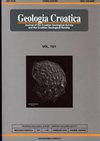在克罗地亚首次发现的杜姆铁矿:其化学成分及其作为火成岩矿物出现在白榴石寄生伟晶岩中的情况
IF 1.1
4区 地球科学
Q3 GEOLOGY
引用次数: 0
摘要
本文首次描述了克罗地亚的杜姆铁矿。杜姆铁矿形成于一条伟晶岩堤内,该伟晶岩堤切割于白垩纪莫斯拉瓦奇卡戈拉山岩浆-变质复合体的双云母白花岗岩中。伟晶岩堤显示出岩浆矿物组合,包括粗粒石英、正长石、微斜长石和白云石,以及含量较少的黝帘石、生物黄铁矿、粉红色安山岩和蓝色棱柱形杜莫斯特岩 I 晶体。随后富含钛的热液蚀变导致团铁矿 I 和安山岩部分被富含镁和钛的次生纤维状至针状紫色团铁矿 II 所取代。在温度降低的过程中,长石中出现了透辉石,而在更晚的阶段,绢云母不仅部分取代了长石,还沿着晶界和裂缝取代了安达拉石和两种杜姆铁矿。在极低温度下进行的最终蚀变形成了粘土矿物,牺牲了长石。根据矿物化学分析,长石以白云石和 K 长石为代表,其中白云石成分较少。黑云母与黝帘石相对应,它的近面体形状和化学成分表明它是由地壳来源的过铝熔体岩浆结晶而成的。粗云母片含有 1.31-1.48 重量%的氧化铁和 0.56-0.70 重量%的二氧化钛。它们的 Na/(Na+K)比率(0.08-0.09)证明其来源于岩浆,而绢云母中较低的比率(0.04-0.06)则表明其形成于逆冲过程中。岩浆麝香石与安山岩在质地上处于平衡状态,这也意味着后者起源于火成岩,属于长粒火成岩中安山岩的 S3 质地类型。电子微探针分析清楚地表明,在这两种类型的杜姆铁矿中,硅的四面体缺失(3-Si)与 Al+Ti 的总和(R2= 0.85)之间存在很强的正相关性,这意味着 Al 被 Ti 替代。然而,钛对铝的置换并不像一般认为的那样仅限于八面体位置上的铝,很可能还包括四面体位置上的铝。通常用[Fe/(Fe+Ti)]x100 因子来解释杜姆铁矿中不同的多色性颜色,但根据这项研究,在[Fe/(Fe+Ti)]x100 因子比以前提出的更高的情况下,镁含量升高会使红色至紫色杜姆铁矿稳定下来。本文章由计算机程序翻译,如有差异,请以英文原文为准。
First occurrence of dumortierite in Croatia: its chemical composition and appearance as an igneous mineral in leucogranite-hosted pegmatite
In this article, dumortierite from Croatia is described for the first time. Dumortierite formed in a pegmatite dyke cutting through Cretaceous two-mica leucogranite of the magmatic-metamorphic complex of Mt. Moslavačka Gora. The pegmatite dyke shows a magmatic mineral association of coarse-grained quartz, orthoclase, microcline and albite, less abundant muscovite, biotite, pinkish andalusite and blue-coloured prismatic dumortierite I crystals. Subsequent alteration by titanium-rich hydrothermal fluids led to partial replacement of dumortierite I and andalusite by secondary fibrous to acicular purple dumortierite II enriched in Mg and Ti. During temperature decrease perthite developed in feldspars and at a still later stage, sericite partially replaced not only feldspars but also andalusite and both types of dumortierite along grain boundaries and cracks. Final alteration at very low temperatures caused formation of clay minerals at the expense of feldspars. According to mineral chemical analyses, the feldspars are represented by albite and K-feldspar with a low albite component. Biotite corresponds to annite and its subhedral shape and chemical composition point to magmatic crystallisation from a peraluminous melt derived from a crustal source. Coarse muscovite flakes contain 1.31-1.48 wt.% FeO and 0.56-0.70 wt.% TiO2. Their Na/(Na+K) ratios (0.08–0.09) prove a magmatic origin, whereas lower ratios in sericite (0.04–0.06) indicate formation during retrogression. Magmatic muscovite is in textural equilibrium with andalusite, also implying an igneous origin for the latter, which belongs to the S3 textural type of andalusite in felsic igneous rocks. Electron microprobe analyses clearly show a strong positive correlation between Si tetrahedral deficiency (3-Si) and the sum of Al+Ti, (R2= 0.85) in both types of dumortierite, implying Al replacement by Ti. However, Al replacement by Ti is not restricted to Al in the octahedral position, as generally accepted, but most probably also in the tetrahedral position. Distinct pleochroic colours in dumortierite are usually explained by the [Fe/(Fe+Ti)]x100 factor, but according to this study, elevated Mg contents stabilize red to violet coloured dumortierite at higher [Fe/(Fe+Ti)] x100 factors than those previously suggested.
求助全文
通过发布文献求助,成功后即可免费获取论文全文。
去求助
来源期刊

Geologia Croatica
GEOSCIENCES, MULTIDISCIPLINARY-
CiteScore
2.90
自引率
23.10%
发文量
35
审稿时长
>12 weeks
期刊介绍:
Geologia Croatica welcomes original scientific papers dealing with diverse aspects of geology and geological engineering, the history of the Earth, and the physical changes that the Earth has undergone or it is undergoing. The Journal covers a wide spectrum of geology disciplines (palaeontology, stratigraphy, mineralogy, sedimentology, petrology, geochemistry, structural geology, karstology, hydrogeology and engineering geology) including pedogenesis, petroleum geology and environmental geology.
Papers especially concerning the Pannonian Basin, Dinarides, the Adriatic/Mediterranean region, as well as notes and reviews interesting to a wider audience (e.g. review papers, book reviews, and notes) are welcome.
 求助内容:
求助内容: 应助结果提醒方式:
应助结果提醒方式:


